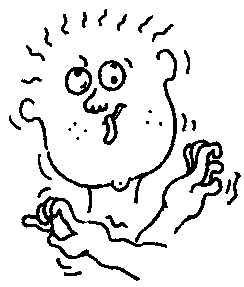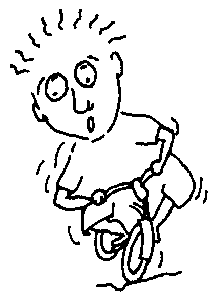Insight Meditation Online
Introduction to Insight Meditation
by Venerable Sujiva

The Main Control
The main controlling faculty of the mind is mindfulness. Remember the moments when you were calm and composed? The awareness that comes with them is also bright and clear. As a direct opposite of it are those times you were panic-stricken or completely confused. Therefore, with mindfulness you can do any job as well as you possibly can, be it driving a car, cooking a meal or answering some examination questions. But this potential is not recognized as much as other things, like faith and concentration, and so is not emphasized. If we are to develop it until it is really strong, lasting and revealing, then life will breeze by, if not ecstatically, then at least smoothly.
Benefits of Mindfulness – Worlds of Difference
Sometimes, people say, there is a thin line between sanity and insanity. The mad genius, for example, is not far from being a maniac. That’s why Frankenstein was invented, and so was the Terminator. In any case, bombs of all sorts are bad. But no matter how thin a line it is, it is still a line and even if it is really thick, if you are confused, you will still miss it.
Mindfulness actually is the line. When you are unmindful, such as when you are in a rage, you are indeed not different from a madman. It is only a matter of degree. When you have zero mindfulness over an extended period, then you can safely conclude that you are crazy. So, if you don’t want to go mad then hang on to your dear mindfulness, for on the other side, that is, at the bottom, is living hell. Sanity is indeed a thin line. It really does not need much, so to speak, to break a person. Lock him up without contact for a few days or weeks and there you are, someone fit for the mental ward.
If you are a meditator, you’ll have a fighting chance and maybe even end up saner than anyone else. But they may still call you mad because you are different. I remember how some people considered a friend mad because he was not his usual excitable and irritable self after a retreat. They were satisfied only when they managed to infuriate him. Can you imagine how this can be so, when they themselves are supposed to be regular meditators? Who then is mad? But if you’re really mindful then you know for yourself, without doubt, that your mind is clear and thinking rationally. It is they who are confused.
If it goes without saying that with mindfulness the mind is pure of defilements such as greed, anger and delusion, then it will also mean that it draws the line between genuine happiness and suffering. We can understand why anger and delusion are suffering but not greed, especially when it comes with joy. That is because joy tends to muffle the real state of mind. Take away the joy and what do you have left? There will be a really restless state of craving and tenacious clinging. It is like someone who is hungry. Therefore, if you will have real happiness, then look for peace of mind that is born of purity and mindfulness.
It is a kind of happiness that is truly satisfying, strengthened by noble purpose. No sensual pleasure can be equal to it. Besides, it can be freely obtained (as long as you practice), and you don’t have to pay anything to acquire it.
Mindfulness can also be the deciding factor between life and death. A lot of careless mistakes and oversights end in death. It may be just a slip on the stairs, a ladder, or along the road. Traffic accidents claim lives daily. Then there are electrical short circuits, or even choking through unmindful eating. It not only means your life, but also others. What happens after that? If you are mindful at the moment of death, it can mean a happy rebirth. If not it can mean hell. Buddhists believe in the Law of Kamma (Law of Retribution). Mindfulness means meritorious kamma and defilements mean unwholesome kamma. All these – done throughout one’s life – also add to the store of forces that decides what will happen next – heaven or hell.
Last but not least, Mindfulness is also the factor that differentiates between Nibbana and Samsara (Cycle of birth and death, suffering). In the Noble Eightfold Path, the fulfillment of morality, concentration and understanding depends on the building up of mindfulness. Without mindfulness, there cannot even be any moral base. Finally, the culmination of insight is that extremely strong and sharp mindfulness that penetrates through the thick veil of ignorance to realize that everlasting Peace, Nibbana. So until then, please try to be as mindful as possible, to get out of the cycle of birth and death, suffering, Samsara.

Gaining a Hold on the Main Controls
Now that you realize (I hope) how important it is to have mindfulness, you may, perhaps, be interested to know how to go about cultivating it to make all the difference.
The main idea is to develop this awareness until it becomes habitual and continuous, and then apply it for more specialized purposes, such as gaining knowledge and skills.
To begin with, let me offer you certain suggestions which will be definitely be helpful in some way. These are simple exercises which you can safely try out. They come under three sub-headings:
- Walking Meditation
- Sitting Meditation
- Mindfulness of Daily Activities.
Walking Meditation
Can you imagine the extent of things which involve walking? You walk to the office, walk for exercise, for sight-seeing, to the dinner table, to ease yourself and many other wonderful – as well as unmentionable – things.
But one can feel and think quite differently when taking a casual walk along an isolated beach in the light of dawn, than when taking a walk heading for the dentist’s chair. It’s all in the state of mind. And mind you, that state of mind can determine where you will end up and how you fare. If you walk so unmindfully, you may end up either in the hospital or the grave. Of course, nowadays many people cut down on the walking, they go on wheels. At such speeds that modern technology provides, you may have to come up with even more mindfulness to ensure safety.
Let me offer you a few tips to start off your walking meditation:
To learn walking mindfully, you have to find a quiet spot with a fair distance, at least thirty feet. Preferably on a straight, clean and level path, without anyone around to stare at what you are about to do. Failing this, any distance of up to ten steps will also do.
First, you must try to bring to mind the clear awareness of your own standing posture. It’s not visualization, but feeling one’s body as it is – the tension, firmness and maybe a bit of swaying. Make sure you are relaxed, with a straight posture. Hold or fold your hands together to help keep your composure. You may close your eyes and make the mind free, calm, relaxed and happy. Learn to let go of all your problems and thoughts. They are not worth clinging on to all the time. Give your mind a break. Just be with the present moment and be aware.
Now, after having gathered your calm composure, start walking, keeping the attention at the lower part of the moving foot, below the calves. Walk freely (with eyes opened) at a pace you feel most comfortable and relaxed with. To help keep the mind at the feet you may mentally say right, left or walking, walking – or whichever word you prefer. And remember, don’t think, just keep the mind in the present moment.
When it’s time to turn, be aware of the turning action.
Whenever the attention runs to thoughts, you will then have to recall your awareness, noting mindfully: thinking, thinking – and then return to the footsteps. If tension or boredom creep up, you will again have to stop walking, to bring back your awareness in the way you did. While standing, note tension or boredom mindfully, before resuming the walking meditation.
I would advise you to walk at a certain rhythm which the mind can catch on to. Once caught on, it will tend to flow along. Then, maintain that rhythm for the time being.
When you feel much calmer or somewhat tired, then you can slow down your pace, and at the same time be even more relaxed mentally and physically. People who have gained concentration in this way can walk for an hour or more, and yet feel as if only a minute has passed. They feel weightless and seem to be walking on clouds. You can end up very blissful!
There is, however, one thing to add. When you feel really relaxed, keep your mind keenly aware as it flows along with the footsteps. Try to feel or sense the sensations that flow along – the tension, pulling and pushing forces, the lightness or weight and, finally, the contact of the soles on the ground.
To help the beginner gain a keener perception of this, teachers have devised a method breaking each step into various phases, starting from two to six. Although three phases are sufficient for most people, they can be increased progressively – but only when one is ready for it.
During an intensive retreat or formal meditation exercise, the standard procedure is to do one hour of walking meditation, dividing it into three periods – the first twenty minutes for one-phase walking, a second twenty minutes for two-phase walking and the final twenty minutes (adding up to one hour) for three-phase walking.
The principle behind this is to gradually bring the mind to a more concentrated awareness, which can come about with slowing down, and a more thorough observation. As to the most suitable type of walking, it will be the type that arouses the most mindfulness.
The phases of the steps, from one to six, are:
1. right/left
2. lifting, stepping
3. lifting, pushing, stepping
4. (heels) raising, lifting, pushing, stepping
5. raising, lifting, pushing, lowering, stepping
6. raising, lifting, pushing, lowering, treading, pressing.
At each phase of a step, when observing closely, one will be able to perceive the sensations or forces that can be felt along with it. One can actually experience it as a flow of tension, thrusting forces, or a spread of hardness when stepping.
To make the picture complete, the intentions that arise prior to each length of walking, the intentions to stop, to turn, are also mindfully noted.
If you can do this, you may actually arrive at a point where you completely forget about yourself, and what is left is the process of awareness with its objects. Then you have begun the journey within, the path to realize the Nature of Who and What we really are. Then all conflicts with Reality, due to ignorance, which is the root problem of suffering, may finally see the end.
Sitting Meditation
The same principle used in walking meditation is applicable to sitting meditation, only with a difference of basic objects. What principle?
The principle of three steps in mindful observation:
1. To be mindful
2. To follow or attend to the object of observation mindfully.
3. To observe into the Nature of the object without thinking and concepts.
Nature, here, refers to the process of sensations which goes to make up the object which we are observing.
While one is walking, one mindfully follows the footsteps and observes the process of sensations that make it up. Sitting meditation makes use of the sensations of the abdomen as one breathes. Some, however, use the sensation of the breath at the nose tip.
Usually, people who meditate will sit cross-legged with their back straight and their eyes closed. Those with stiff knees can sit on chairs. Do not lean back, as this will not be too helpful in keeping up the awareness, although it will do very well if you intend to relax completely into sleep, in which case you might as well lie down.
Breathe normally and, as you do, keep the mindful attention on the sensations of the movement as the abdomen rises and falls.
Mentally, say ‘rising’ and ‘falling’ in conjunction with the respective movements.
To help beginners keep track of the sensations of motion, they may rest their palm lightly on that area, until they become familiar with the object.
When the mind wanders to other objects, such as thoughts, sounds, itches and so forth, recall your awareness as soon as you realize, noting mentally: thinking, hearing, etc. and then return to your original object.
You will notice, when you try to do this, how intractable and slippery the mind is. Well, at least you are getting to know yourself better and doing something about it!
With practice, the mind will wander less and stay with the rising and falling movements. Then you can proceed to the next step of thorough observation. At first you can only perceive up and down movements. With effort you can notice much more. The movements vary greatly from time to time. They can be long or short, fast or slow, smooth or jerky, and so on. Even within the rising movement there can be many various sensations arising and passing away. Again, it finally ends up as mere processes of the mind and its object.
Finally, pain is often the last to call before you give up. Try to ignore it if it is minor, but if it stands out and grabs your attention, then you will have to make it your main subject of observation.
The idea is to make use of it to train in mindfulness (and also, in this case, patience). The three-point observation principle also holds water here. You first have to watch pain with mindfulness. Then watch it for some time without being irritated by it. If you can do that, then you can look into the Nature of the pain, whether it is hard, hot or numb. It could also be pulling, twisting or cutting. There are more types than you can imagine, and it can be very interesting.
After that, you can proceed to discover its process – how it arises, changes and breaks up. It is possible to gain deeper understanding of your own Nature through observation of pain. Pain is part of your individual makeup. When you cannot bear it any longer, then it’s time to get up.
Daily Activities
One of the first things to learn is about mindfulness itself. We read about it, hear about it – now we’re getting to know it through direct experience. It’s not just knowing something. It’s knowing it with a clear, steady mind. In that way you can’t be wrong. Besides, there cannot be any defilements – attachment, anger, delusion, sloth, restlessness, skeptical doubts, jealousy, and so on. Once you can define it, it is not difficult to call it up. It’s just a matter of will. How wonderful it is to be mindful all the time! But before that can be so, you will have to be able to distinguish clearly between the states of mindfulness and non-mindfulness. After that, it is up to you to practise, practise and practise.
In a way, maintaining mindfulness is comparable to making a journey. There you are, on your bicycle, going along the rough roads and crossing torrential streams. You need to keep an eye on the road, balance your bicycle and keep on paddling. It takes considerable trials and errors before you acquire the skill. Similarly, in life or in meditation one needs to have experience in handling the various situations and objects that one comes across. And when something particularly trying comes along, one can become bogged down for quite a while until he has learned to get over it. Pain is an example. It is also an inescapable feature of life.
Once one is able to know what this mindfulness – and maintenance of it – are all about, then one may go on to be mindful of all one’s own activities as best as one can, and as often as is practical. It will begin from the moment one wakes up from slumber, one notes mindfully the opening of the eyes. In the same way one maintains mindfulness when one gets up, washes, eats, drinks and so on, throughout the day – until one finally lies down to sleep again at the end of the day.
During eating, for example, one will have to mindfully note the actions involved step-by-step. Firstly, the intention to eat, then the looking at the food, the stretching of the hands, the scooping of the food, the bringing to the mouth, the opening of the mouth, chewing, biting, swallowing and all other steps. During a meditation retreat, one can afford to slow down one’s actions to help concentrate the awareness as much as possible. In fact, one can be quite oblivious to the surroundings. Finally one will, as in sitting and walking, be left with mere processes.
However, at home or at work, one will not be able to practise mindfulness in this concentrated manner. Usually one will be able to do so only at a general level. Only when one is free can one resume one’s mindfulness during the formal exercises with the desired intensity.


